
|

Beneath Apache Country:
by Alan Sussex
Reprinted from MEMO, Mendocino, Ca, October, 1992 thru January, 1993.
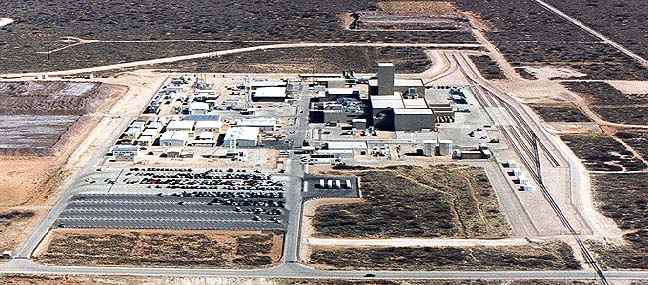
Aerial view of the Waste Isolation Pilot Plan (WIPP)
It is 11:30 AM, as Howard, my Westinghouse guide and I proceed toward the enclosed elevator tower that will take us 2150 feet down into the salt. Curtis had just arrived, he’s an engineer who would accompany us to answer any questions that I might have.
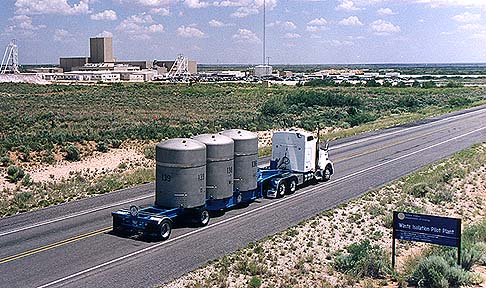
A transuranic package transporter (TRUPACT-II) travels to the U.S. Department of Energy's Waste Isolation Pilot Plant (WIPP) near Carlsbad, New Mexico. The tractor-trailer and specialized containers are designed to safely transport radioactive waste to the WIPP.
We have just come from the building where trucks transporting the plutonium waste, in 10,000 pound, double-walled stainless steel containers will off-load their cargo. The containers are about 10 feet tall and 5 feet in diameter. Each open flatbed trailer can carry three of them. All of the waste will be shipped from 10 sites around the USA by truck only.
Generators include the Savannah River site in South Carolina; Oak Ridge Reservation in Tennessee; Mound Plant in Ohio; Argonne Facility in Illinois; Hanford Nuclear Works in Washington; Idaho National; Lawrence Livermore Ca; the Nevada Test Site; Rocky Flats Colorado; and Los Alamos National Laboratory, NM..
Two drivers in each truck will take turns driving five hour shifts non stop until they reach WIPP. Every truck will be tracked by the TRANSCOM satellites which have it pinpointed within five feet of its location from 26,000 miles out in space.
Thousands of trips across the US will be necessary to transport the waste to Carlsbad, New Mexico.
Plutonium 239 is the most deadly substance on earth. It gives off Alpha radiation. If breathed, ingested or if it enters a break in the skin it will eventually cause death. It can also be passed up and down the food chain; for instance, if a cow eats contaminated grass, plutonium can end up in the milk or meat to be passed along, mutating cells all the while, wherever it is.
Once the animal, or you, dies, the material remains active and deadly for over 50,000 years, passed on to all the other creatures that complete life’s natural process of recycling and decay. Moved by the wind or water, it’s virtually undetectable unless you have a Geiger detector and get within ¼ inch of it. It takes only one millionth of a gram to kill. It is man-made. It takes about one million years to totally decompose.
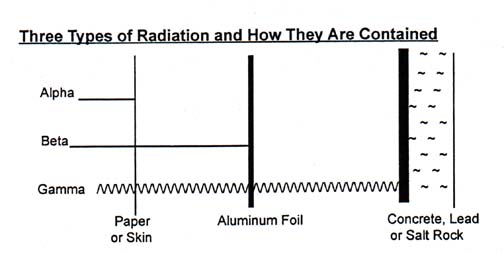
So far there are 50,000 tons of plutonium 239 in the USA. There may exist six times or more that amount in the rest of the world. By the year 2000 there will be 80,000 tons in the USA. About half is produced by the Defense Department. The other 40,000 tons are the unstoppable byproduct of commercial nuclear reactors. It is planned to place 40,000 tons on Native American reservations at MRS facilities (Monitored Retrievable Storage) for between 40 to 50 years. By then, the DOE hopes to have Yucca Mountain in Nevada available to accept commercial fuel rods.
The WIPP facility in New Mexico will also be accepting nuclear waste that gives off Beta and Gamma radiation. Gamma rays can travel through three feet of concrete and can cause great damage to internal organs if you get close to it. Items giving off Gamma radiation take 500 to 1,000 years to decay. Three percent of the waste sent to WIPP will need to be handled with remote equipment in order to avoid these deadly Gamma rays. The 6.5 million cubic feet destined for the Waste Isolation Pilot Project (WIPP) is only about 1 percent of the total volume that currently exists. Many more burial sites will be needed in the near future.
There is a kind of doublespeak that goes on when you’re around these places or when you read the literature. By giving these places and things different names, the sense of risk is reduced to what is actually going on. The risk has been sanitized and the danger neutralized as a result:
The double-walled 3/8 inch thick (each wall) stainless steel containers are called Trupack II, short for TRansUranic (plutonium 239) Package. While enroute, the Trupack will be monitored to see if the containers inside (55 gallon drums) are leaking radiation.
|
WIPP Shipments Will Be Continuously
Monitored for Added Safety All tractors are equipped with speed governors, and they carry properly calibrated radiation detection instruments. All WIPP shipments are monitored by a state-of-the-ant computer-based, satellite-linked tracking system, called TRANSCOM, which is linked to the Central Monitoring Room at the WIPP. States and American Indian tribes potentially impacted by WIPP shipments can monitor those shipments through the TRANSCOM. |
| Special Containers | |
| The U.S.
Department of Energy designed and tested an elaborate system for safely shipping Transuranic radioactive waste to the Waste Isolation Pilot Pant. The container, called Transuranic Packaging Tnansporter Model 2, or TRUPACT-II, is: · Eight feet in diameter and 10 feet high. A series of stringent tests conducted on the container included: · A drop from a height of 30 feet onto an unyielding surface. The tests showed that the container would hold its seal and prevent release of radioactivity to the atmosphere. |
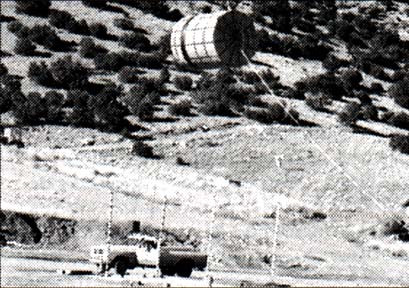 |
Once at WIPP they will again peek inside the Trupack through a small plug to detect Alpha radiation. If all is well, its base is secured, while the top is gripped by a sophisticated lid remover, like taking the top off a very tight jar. They call it Trupack II because it has 2 rubber "o" rings around the mouth. Trupack I only had 1 "o" ring. Now it’s twice as safe.
Once the lid is popped, the drums are removed from inside and then taken to the elevator that we’re going to take 2150 feet down into the salt. There is a second elevator on site which brings up the excavated salt, where it’s deposited nearby.
In addition to the two elevator shafts, the ventilation system has two separate shafts that circulate air through the 10-mile grid system of tunnels below.
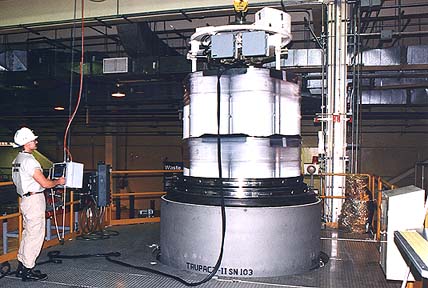
WASTE ISOLATION PILOT PLANT
The Transuranic Package Transporter-II (TRUPACT-II) is on a dock in the Waste Handling Building. The barrels are being removed from the inner containment vessel.
The exhaust vent has scrubbers(filters) that are intended to catch any material Alpha particles that may get past other material scrubbers within the salt. (In Golden, Colorado, Rocky Flats - a plutonium refinery for making weapons - grade explosive material - is located. The Rocky Flats system of keeping track of plutonium and out of the environment just hasn’t quite done the job. Originally, 63 pounds of the deadly material turned up missing. They have since shut down the plant and found 11 pounds in the vent system. They have yet to find the rest.)
Before anyone can get near the "239 waste" elevator, they must first be checked into the office to reconfirm their reason and destination into the salt. We each sign in on the log for going down below. We’re given a brass numbered tag, the size of a quarter. Mine is V-11 (also logged). A matching tag is placed on a second board that represents everyone "down below." This same system has been used by miners for more than 150 years.
In the event of an accident, a glance at the board would show what numbers are down there, then a check of the log would show who they are. In addition, the brass tag in my pocket wouldn’t melt in the event of a fire and could be used for identification.
Leaving that office, we walk on over to another separate narrow guard house that everyone going below must pass through. Two armed military guards let us in, and we thread through a detection device. Guards dressed in silver-blue bloused jump suits check our tags and identification clipped to our shirts. We are directed to draw a plastic card from a long metal box held by a guard. I slip out the next card in line, it’s black with the silver silhouette outline of the WIPP complex of structures on it. If one comes up with a red spot on it, a body search is required. Mine has no spot.
The door is unlocked and we are allowed to exit. We walk towards the building complex that has the elevator tower.
Part Two
As we walk towards the elevator that will carry the plutonium 239 contaminated waste 2150 feet down into the salt, I again notice the unusual lightning rod scrubbers mounted atop the higher structures around the complex of buildings.
They look like clothless umbrella frames about 12 feet in diameter, with small balls attached to the wire ribs. The sun sparkles off them as they bob and dance in the light breeze, like forgotten Christmas decorations. Their purpose is to remove static electricity, to prevent lightning from striking this critical area.
Entering the first door, I can feel the rush of air being sucked inside the building. This is to prevent any loose radioactive particles from escaping the building. All the structures that handle the waste are designed in this manner, including the first one we were in, where the Tru-Pack containers are off-loaded from their transport vehicles.
But what goes in must eventually go out someplace else. Will deadly sub-microscopic particles get past the filtered exhaust system?
We pass through a second airlock, then a third. Each set of doors is designed to be an additional safety barrier. Already wearing our hard hats, we stop at a dressing station to put on the rest of our gear before we can go below.
First we put on a thick, heavy 3-inch belt used to hang the other necessary apparatus on. Next, a breathing pack is affixed to the belt. It contains a mask and chemical filter. It can change deadly carbon monoxide into breathable carbon dioxide for one hour in the event of fire and smoke. It weighs about 4 or 5 pounds. Then we strap a battery, cord and light to the belt. Another 5 pounds. It all reminds me of wearing a pistol belt and helmet in the army.
The three of us proceed through two more airlocks into the elevator shaft room. Tracks to bring the waste in lead up to it. With our headlights turned on, we board the elevator. It’s bad manners to look at the person you’re talking to when wearing a headlight; I offset my helmet slightly. The elevator is the size of a living room.
Starting down there is some scraping as the elevator slides off its stabilizing pins. The pins keep it from moving while being loaded. As the light disappears above us, we’re left in darkness except for our helmet lamps.
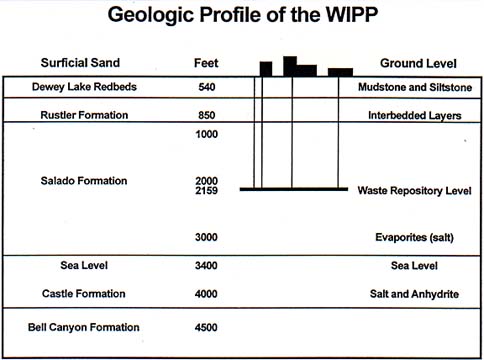
Moving down it’s completely silent. My light shines through the heavy mesh cage onto the walls zipping by. The elevator is laser-guided - there isn’t any side movement, it feels like we’re not moving at all. At 450 feet per minute, it’s a 5-minute trip to the bottom.
My headlight shines on the balance weight as it passes by on its way up. We slow as we near the bottom. The air is a humid, sticky 82 degrees. A bit more crashing on the alignment pins again. Hazy light enters the cage. The door opens into a long tunnel that disappears into the distance. The thought of an earthquake and all of this collapsing on itself crosses my mind. This is not a place for the claustrophobic.
The ventilation system is a roar around us. It’s sound will be with us throughout the 10 miles of tunnels. In one section where it intersects and exhausts to the surface it will be extremely loud.
A maze of electric cables and computer lines meet at this shaft. All are hung 13 feet high, along the ceiling corner of the 33 foot wide salt tunnels.
Howard reports to a woman behind the desk. She checks her computer and types our path and destinations into it. We’re assigned one of the many Cushman electric 4-passenger vehicles parked in line. Golf carts. We board one and start off.

Entrance to Room 1, Panel 1 underground at the Waste Isolation Pilot Plant (WIPP)
The ceilings throughout the system are dotted with large washers. Huge 10 foot lagbolts hold up the tunnels, like hanging a plant or light from your sheetrock with a molly bolt.
The entire tunnel system is gradually moving in on itself from the weight of the ½ mile of salt above it. All the ceilings are coming down at about 3-inches per year, and the walls are moving inward at 2 inches per year each. The bolts are to delay the moment of collapse.
As we motor along I can see where some sections have come down and are now held up with additional lags and layers of chainlink fence. There are fellows that probe the ceilings with metal poles, listening for a hollow sound. When they find it and the weak spot, they’ll pick it down and try to stabilize it. In one place, I can see where they have the lags to monitor the movement. These are wired into the computer system.
A few minutes into our journey, there is a power failure in our section of tunnel, leaving us in complete darkness except for our helmet lights bouncing off the walls and tunnel ahead.
Parts 3 and 4